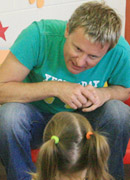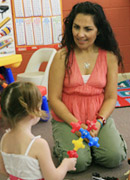Behaviour
Caring for babies
Bottle feeding
Changing a nappy
Cleaning and sterilising bottles
Daily cleaning tasks
Helping new children settle in
Preparing for a nappy change
Sleep patterns – babies
Sleep routines – babies
Toilet training
Caring for children
Allowing time for practice
Dressing/undressing
Mealtimes
Nappy change
Packing away/caring for the environment
Sleep/rest time
Toileting
Common self-help milestones
Tips for sleep and rest time
Self image
Communication
Body language
Limits and guidelines
Ways children communicate
Greeting children and families
Modelling appropriate communication
Questioning
Verbal and non–verbal communication
Acknowledging children's feelings
Listening attentively
Communicating with Aboriginal and Torres Strait Islander parents/carers
Development
Allowing time for practice
Dressing/undressing
Mealtimes
Nappy change
Packing away/caring for the environment
Sleep/rest time
Toileting
Common self-help milestones
Creative development
Language development
Modelling positive relationships
Physical development
Sharing and taking turns
Sleep patterns – babies
Sleep routines – babies
Encourage independent problem solving
Fundamental movement skills
Health, hygiene and safety
Coping with stress
Correct manual handling principles
Daily cleaning tasks
Hand washing
Hand washing poster
Manual handling overview
Toilet training
Safety checklist
Learning experiences and play
Environmentally friendly learning experiences
Learning experiences for different development areas
Creative resource materials
Arranging the environment to facilitate learning and pleasure
Indoors and outdoor areas
Creating a positive physical environment
Legal and ethical issues
Child abuse case studies
How do I recognise when a child or young person is at risk?
Tips on dealing with disclosures
Observation methods
Arranging Experiences (PDF 351Kb)
Recording observations
Rules for making observations
What you can learn from observations
Programming
Children’s interests, strengths, needs and skills
Extending the children’s interest in dinosaurs
Objective observation
Planning an OSHC environment
Behavior management plan
Planning enjoyable experiences
Planning experiences for 0 - 2 years age group
Planning experiences for 2 - 3 years age group
Planning experiences for 3 - 5 years age group
Listening attentively
You know that you are really being listened to when you have a person's undivided attention. When someone's whole body and face are directed physically toward you and they are nodding, you know they want to listen, and they are listening attentively to you.
Why it is important

Listening attentively is just as important to children as it is to adults. Children can be very perceptive, and are likely to feel unsettled if they feel you're not interested in what they're saying.
This skill can be difficult sometimes, particularly if the children are being very noisy or you've had a busy day - just remember that your priority is always the needs of the children.
Reflect on the last time one of your friends said they were listening to you, but you could tell that they weren't. How did you know they weren't listening? How did it make you feel?
How can staff build children’s self esteem and confidence through listening to what they have to say? Record your thoughts in your notebook.
How to listen attentively

When being attentive you need to be on the child's level. This could mean turning towards them, or squatting or sitting down to be at their eye level. It also involves looking at the child, or being close enough to hear them.
You need to find out the cultural or other beliefs a family has when children enrol. For example, in some cultures it is not appropriate to look into a person's eyes.
If a child attempts to interrupt you from a conversation you are having, you need to acknowledge them in some way, even though it is not appropriate for them to interrupt. Politely excuse yourself for a moment, and acknowledge the child by telling them you will be able to listen to them after you have finished listening to the other person. This is good role modelling of appropriate communication skills.